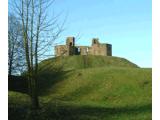Stafford Castle
| |||||||||||||||||||||
This prominent vantage point and strategic site was quickly recognised by the Normans, who built a huge timber fortress here by 1100 AD. In the years shortly after the Norman invasion of 1066, William the Conqueror is believed to have ordered defences to be built against a still hostile and rebellious native community. The fortunes of the castle and its owners, the Stafford family, fluctuated greatly. Earl Ralph, a founder member of the Order of the Garter, built a massive stone keep on top of the motte in 1347. In 1444, Humphrey Stafford was created Duke of Buckinghamshire and the castle reached its heyday. By the early 17th century, the castle's fortunes waned. During the early part of the Civil War it was defended by the Gallant Lady Isabel but was eventually abandoned and demolished. Extensively rebuilt in the Gothic Revival Style in 1813, the castle fell into ruin through this century. A programme of archaeological excavations has gradually revealed many of its secrets. Visitors can follow an informative trail of interpretation panels to discover the castle's history. Today, the remains of the castle, together with the surrounding grounds, give visitors a fascinating insight to the 900 year history of this important site. An inventory taken in 1537 shows how herbs were an important part of daily life at Stafford Castle. They were widely used for their medicinal, aromatic and edible properties. From this detailed inventory, a herb garden was planted in the castle grounds. Great faith was placed in the use of herbs and they still have an important role to play today. This garden has been designed with sixteen beds, each containing herbs related to specific illnesses. As well as being extremely enjoyable to walk around, the herb garden provides a unique insight into living history. The Visitor CentreThe Centre brings Stafford Castle to life. The interior is designed to encourage a 'hands-on' approach to history; the emphasis is most definitely on information with fun. A collection of artefacts from archaeological excavations is on display and guides are pleased to answer your questions on the castle and its site. There is an audio-visual area with film narrated by Robert Hardy explaining the history of the castle. The layout is in the style of a Norman guard house. A scale model of the motte and bailey castle shows what it may have looked like in 1100 AD. The Castle Shop has a wide range of souvenirs to suit all pockets. It features a range of children's books on castles. Throughout the year, Stafford Castle host a diverse programme of events ranging from historical occasions to family fun days. Since 1991, the castle has acted as a backdrop for performances of Shakespeare's plays. There is disabled access to the visitor centre. Toilet facilities (RADAR). | |||||||||||||||||||||
